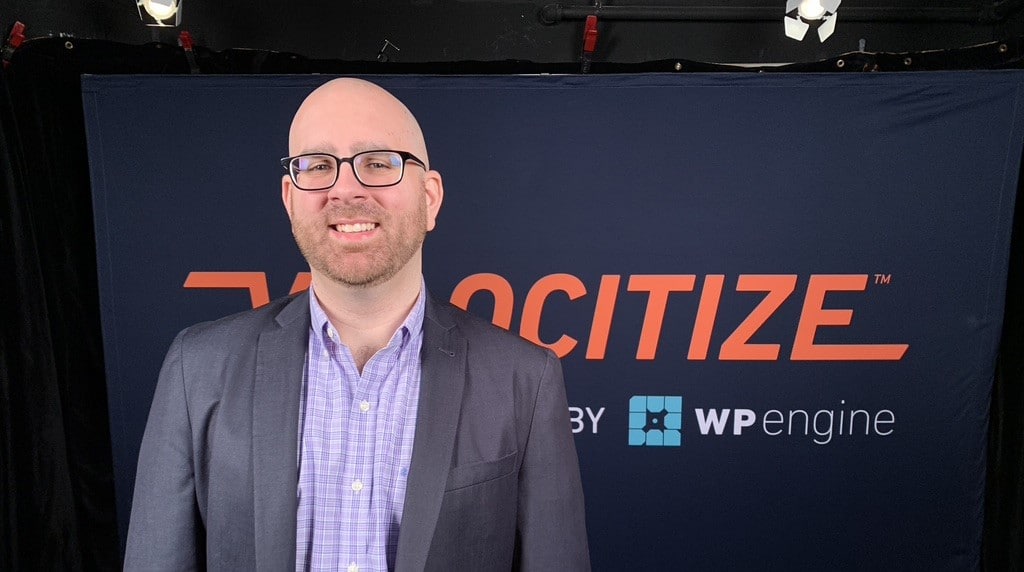It’s like an attention span. I would argue it’s probably half of that now because if you don’t get something on the screen that makes a person want to stay or go deeper, you’ve lost them and they bail.
Neil Harner is the Founder and CEO of Inverse Paradox, an award-winning digital web design agency and a WP Engine agency partner. Neil is also a professor of User Experience and Interaction Design at Thomas Jefferson University.
In this episode of Velocitize Talks, Harner offers his thoughts into the future of ecommerce, the benefits of using WordPress and headless technology, and the importance of storytelling.
You better shop around (1:38)
How do I go get the right rate as the B2B customer, get it into my cart and check out with that sort of seamless flow without having any disruption or interjections from other people within the company?
The B2B ecommerce space, projected to reach over $6.6 trillion this year, is rapidly expanding. This has prompted manufacturers and wholesale businesses to build websites that mirror a B2C experience. In fact 48% of companies now conduct 50 to 74% of all corporate purchases online.
Inverse Paradox has worked with a number of clients to develop sales platforms with quick and easy sales processes which provided better results for the customer and for their business. This is especially critical today given that 65% of shoppers compare prices and check online reviews across multiple sites.
There’s an app (and a site) for that (4:14)
If you can open up your phone and a web browser gives you exactly what you’re looking for, it doesn’t matter if it’s an app or if it’s a browser. That’s not of consequence to the end user.
Harner envisions a future where technology and web design create a better user experience for websites and apps. Customers want a smooth shopper’s experience and near instant load. (In fact, one study suggested that almost half expect ecommerce sites to load in two seconds or less.) In turn, brands want to be able to attract new customers.
The majority of U.S. smartphone users (70%) prefer making their online purchases on websites as opposed to apps. More than half of internet users won’t recommend brands with websites that aren’t mobile-friendly. Combining the benefits of a responsive site with those of a mobile app gives consumers the best of both worlds. And technology is headed in that direction.
WordPress or bust (5:30)
When you talk about building new sites, if you don’t have to completely rework the information architecture, you can focus on just the front end and the features without tearing down the entire system.
WordPress has a great record overall, and is proficient in being maintained and upgraded in a timely manner, Harner says. He finds it beneficial for both the developer and the client because a site can be highly customized within the back-end experience. This allows clients to focus on administration. In fact, WordPress runs over 35% of the internet with access to free updates, thousands of free themes, and 56,000+ plugins.
Speaking your language (10:00)
One of the things I love about the whole premise of headless is that you can have the same back-end infrastructure powering a wide variety of front-end experiences.
Headless technology has many benefits for companies with a portfolio of brands that need to build out a multi-store experience, all while running on the same back-end system. Separating WordPress from its front end isn’t a complicated process due to numerous web tutorials and plugins. It enables you to create systems that can scale quickly without disruptions to the consumer.
According to Torque, a WP Engine publication, a decoupled content management system (CMS) equips developers with the ability to code in the “languages they know best” while leveraging the ultra-flexible WordPress platform as an “organizational or editorial tool.”
Runaway carts (11:10)
There’s a lot more opportunity for storytelling. We need to invest more in getting our clients to actually put money into things like custom photography and custom video.
There hasn’t been a great deal of innovation in the ecommerce user experience and web design. For example, a shopping cart will usually be in the top right corner of any ecommerce website. A comprehensive study of shopping cart abandonment found that around 70% of people will ultimately abandon their carts.
In order to capture a customer’s attention, stand-out product design is instrumental in making customers want to engage, stay on the website, and go deeper.
For more information on Inverse Paradox, check out their website and follow them on LinkedIn.
This interview was originally recorded in February 2020 and has been updated accordingly.
